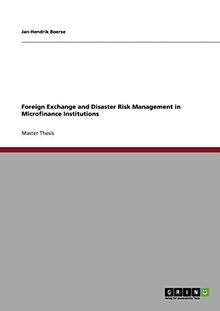
Master's Thesis from the year 2008 in the subject Business economics - Banking, Stock Exchanges, Insurance, Accounting, grade: 1,00, Wiesbaden University of Applied Sciences, course: International Finance, language: English, abstract: Microfinance Institutions (MFI) have left the role of altruistic instruments for donor-assistance and turned into profitable financial institutions and interesting investment opportunities for international financial investors.
However, well-intentioned investments can dramatically increase a MFIs risk exposure and institutions without proper risk management can easily be forced into closure in the aftermath of environmental or economical distress.
Moreover MFIs operate predominant in developing countries counting for 94% of all natural disasters worldwide and the vulnerability of their clients is exorbitant high due to their establishment in simple accommodation facilities and the strong dependence on agricultural business.
Foreign exchange and disaster risks are considered to be two of the most jeopardising threats for MFIs characterised by close interrelations and ignored by the majority of institutions, investors and credit users.
This work compiles a holistic risk management approach starting with the sound assessment of foreign exchange and disaster risks with the aid of modern tools such as hazard modelling and the value-at-risk model.
Based on the institutions particular risk-bearing capacity different strategies to minimise and transfer these risks have been evaluated. More than twenty methods from operational hedges to innovative instruments like indexed weather derivatives or currency and catastrophe swaps are investigated concerning their availability, applicability, effectiveness and efficiency in the microfinance context.
Furthermore this work seeks to design the strategies in a way that overcomes particular obstacles like the Samaritans dilemma to create sustainable security along with rising self responsibility. Consequently the employed instruments have been modified regarding their trigger concepts and payment schemes.
As the implementation of many useful tools would be hampered due to the MFIs size, pooling alternatives between MFIs have been analysed as well as cooperation models with international companies or public private partnerships.
In interviews with global experts from MunichRe, SwissRe and FMO specific issues have been discussed and the feasibility of the strategies could be affirmed.
This work can provide useful guidance for risk managers, investors, donors and all persons that are directly or indirectly responsible for the sustainable development of one or several microfinance institutions.